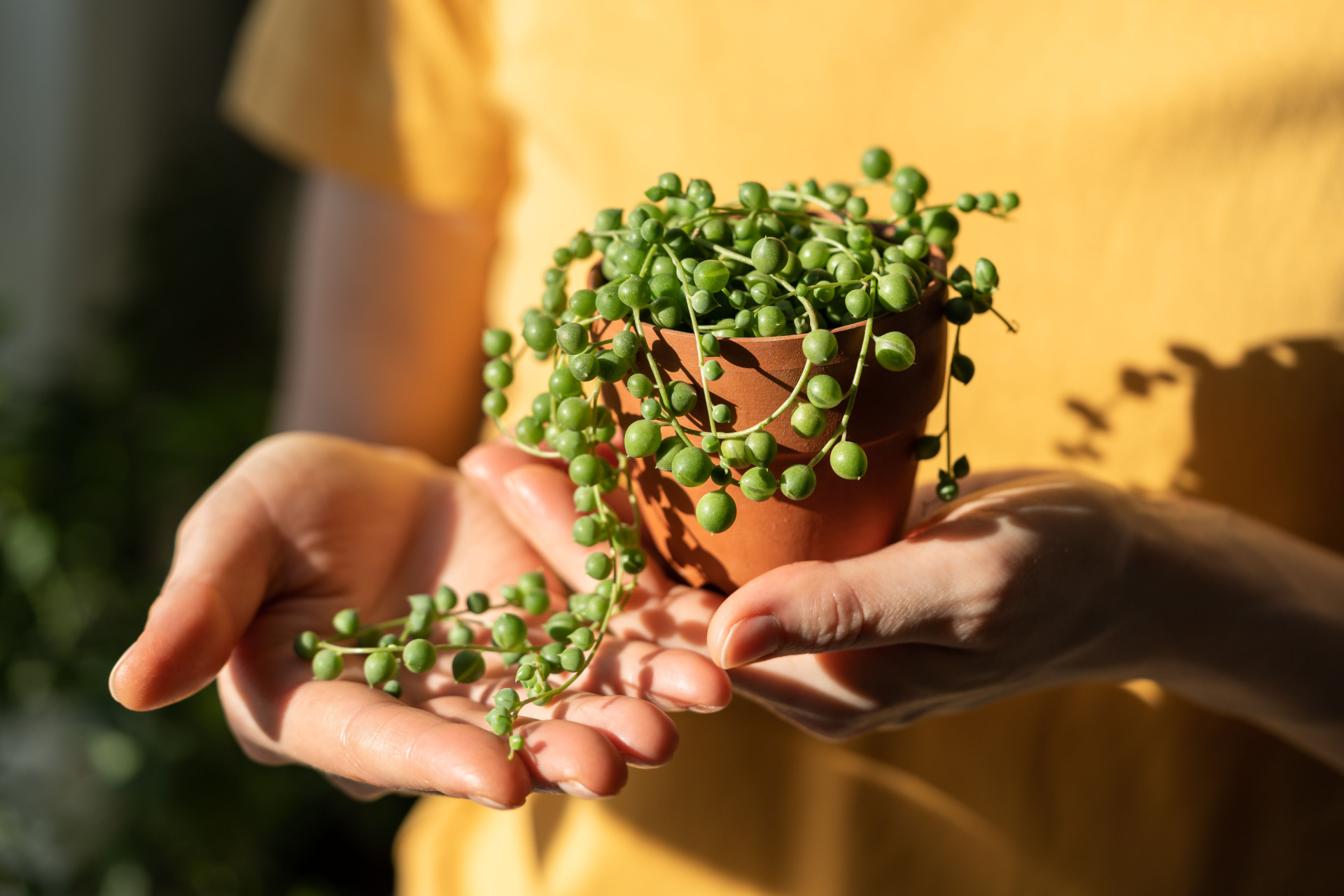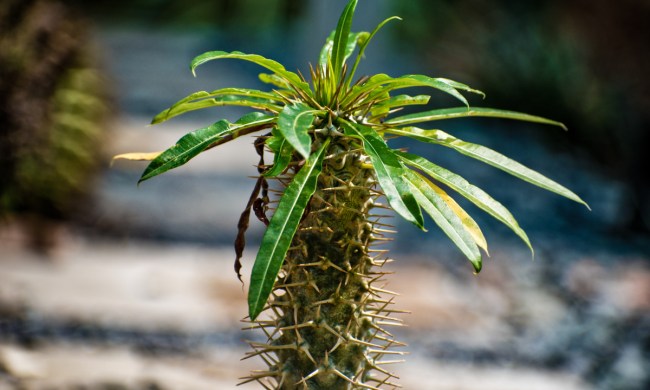A lush philodendron or pothos in a hanging basket can add lovely dimension to an indoor jungle, but you can get even more texture from a whimsical, plump trailing succulent plant.
While many succulents are considered easy to grow, trailing succulents can actually be a bit tricky to maintain. Issues, such as too little light, too little space, and too little watering, can lead to leggy or unhappy growth. Whether you want to bring in a string of pearls or a string of bananas into your home, here’s everything you need to know about trailing succulents care.
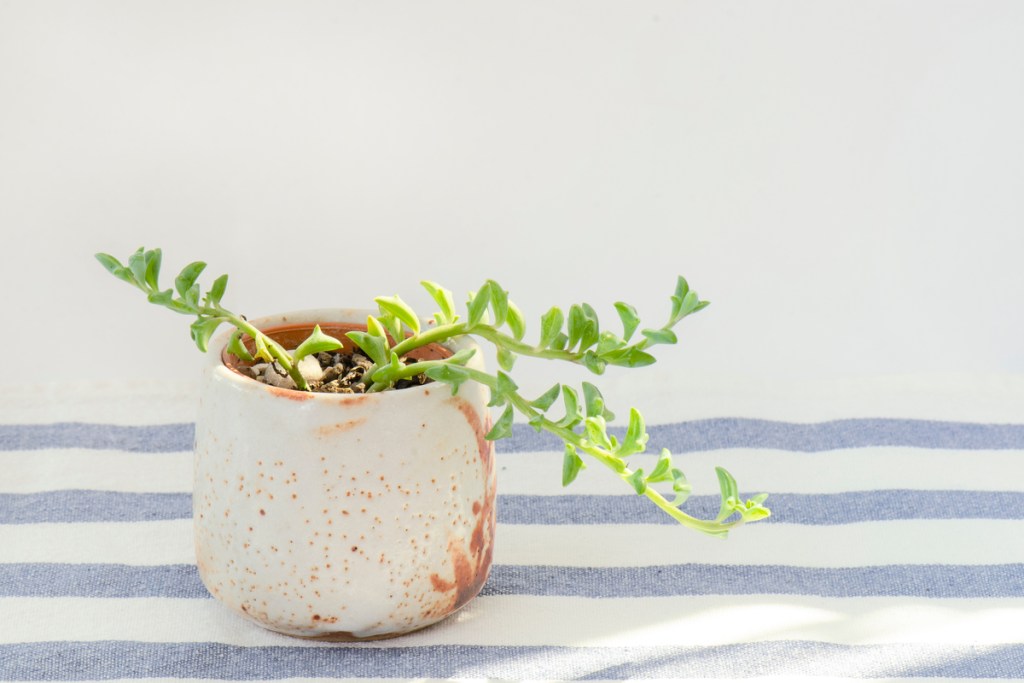
Different types of trailing succulent plants
Trailing succulent plants, sometimes colloquially called "string of things" plants, can come from a wide range of different genera, including Curio, Senecio, and Othonna. While different in classification, they often share similar appearances and care requirements. These vining plants tend to feature thin stems with fleshy leaves that take all kinds of quaint shapes, from pearls to dolphins. Some may even feature cream-colored variegation or vibrantly colored stems.
Because they store water in their leaves, they generally need less water than most houseplants. And because of their succulent nature, they also appreciate bright light for productive growth. Here are a few trailing succulent plants to consider for your collection:
- String of pearls (Curio rowleyanus)
- String of bananas (Senecio radicans)
- String of beads (Senecio herreianus)
- String of tears (Senecio citriformis)
- String of dolphins (Senecio peregrinus)
- String of pickles (Othonna capensis)
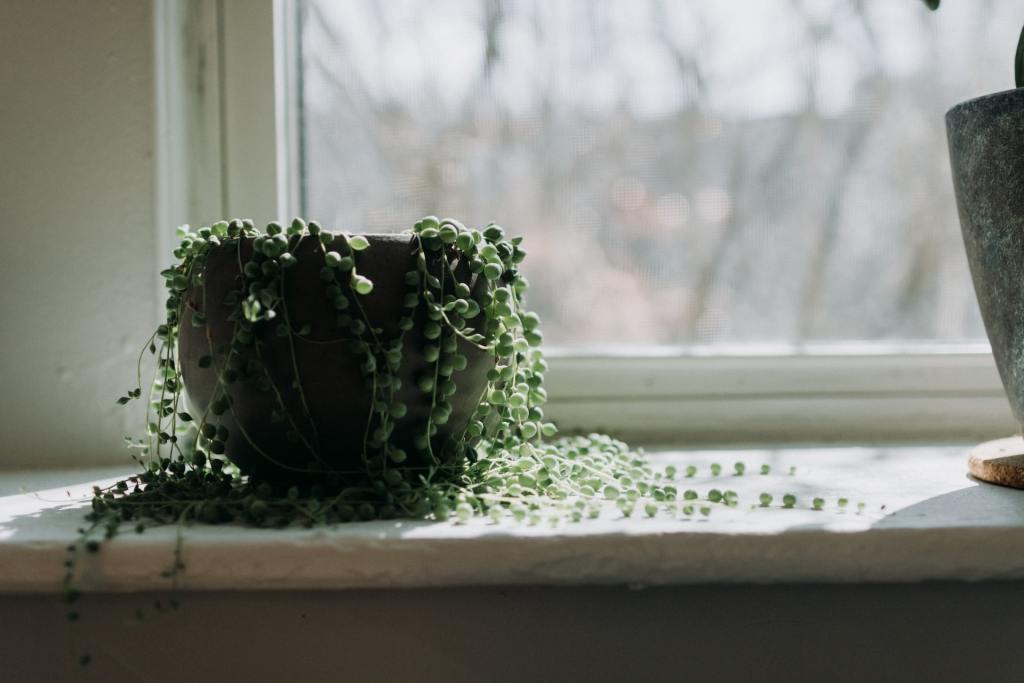
How to give your trailing succulent plant enough light
When you return home with a string succulent plant, the first thing you should do is find a spot for it! Trailing succulents, like most succulents, prefer plenty of light to keep their vines lush and full. But you want to give them filtered light as opposed to harsh, direct light that could burn them.
Step 1: Find a spot indoors next to a south- or east-facing window if possible.
Step 2: Place your plant. Drop down sheer curtains if you get harsh direct light throughout the day, or pull your plant further away from the window if you notice any leaf scorching.
Step 3: To find a place outdoors, look for an area with shade, such as a patio with an awning. Your plant should only get roughly 4 hours of direct sunlight a day.
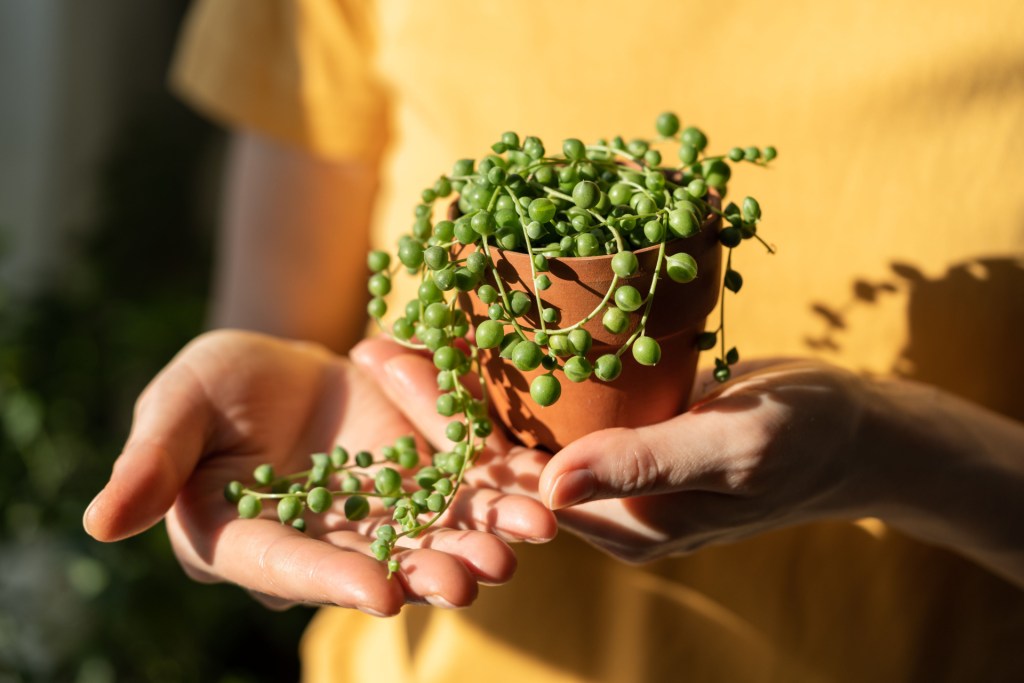
How to repot your trailing succulent plant
When you first get your trailing succulent plant, you’ll want to check its soil. Not only do you need to keep an eye out for pesky pests, but you also want to check how densely packed the soil is.
In general, you want to keep your plant snug but not too tight inside of its planter. It should also have a well-draining medium. If the soil holds onto a lot of water, replace it with a well-draining cactus soil or create your own mix with potting soil, sand, and perlite for sufficient drainage.
Trailing string succulents don’t need to be repotted often because they have shallow root systems. Generally, you’ll only have to repot every five years, and you only need to go an inch or two up in terms of pot diameter.
Step 1: Gently pull your plant from its nursery container. You may want to do this in a plastic box or lay down newspapers to prevent soil from spilling everywhere.
Step 2: Remove any compacted soil from around the roots. It’s OK to keep some of the original soil.
Step 3: In your new planter (ideally one with a drainage hole), add about an inch or two of a cactus soil or your own DIY growing medium with potting mix, sand, and perlite. (The ratio for the latter should be about three parts potting mix, three parts sand, and two parts perlite.)
Step 4: Situate your plant into its new pot.
Step 5: Fill the space between the plant and the container with soil.
Step 6: If you only have a few strings, you may want to use floral pins to wrap the strings around the surface of the soil and secure them down. This will keep them from breaking.
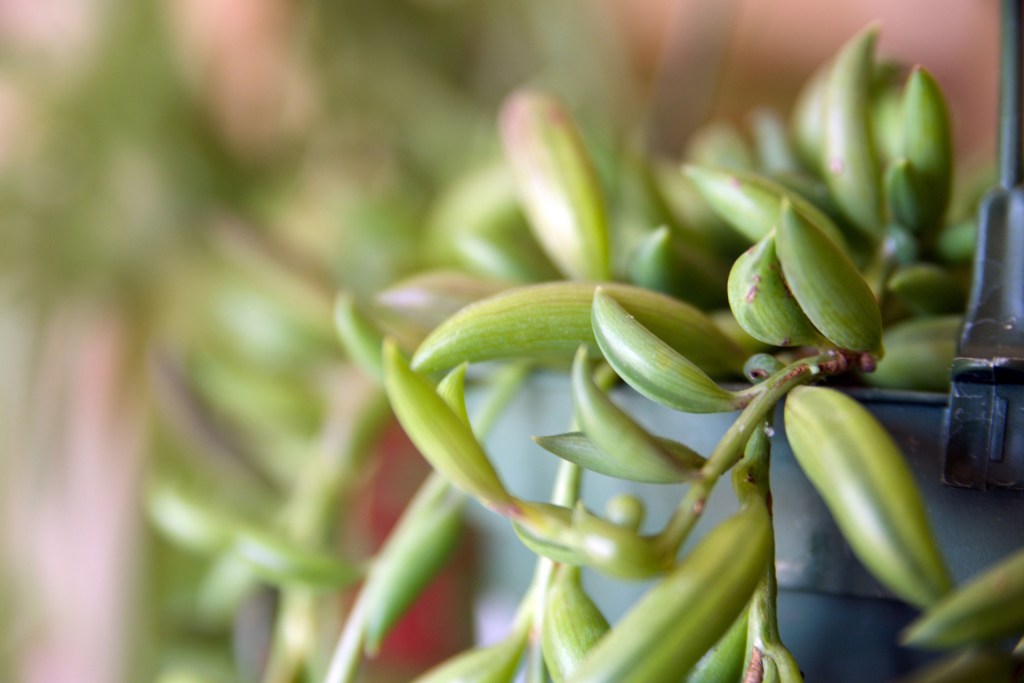
How to water your trailing succulent plant
Trailing succulent plants can be tricky to water, especially since you might not know how to gauge when they need to be watered. Hanging succulent plants sometimes need more watering than regular succulents because of their thin stems, so stay on top of watering for even growth.
Step 1: Check if your plant needs to be watered — the best way is to evaluate the soil with your fingers. You can also use a moisture meter, see if the leaves look wrinkled, or pick up the planter to feel if it’s light.
Step 2: When you water from the top of your plant, thoroughly water the soil until you notice water leaving the planter’s drainage hole.
Step 3: Dump out excess water onto your plant saucer after 15 minutes.
Step 4: If you prefer bottom watering, leave your plant in a bowl or tub filled with water until your plant's soil surface feels damp to the touch.
Step 5: Throughout the growing season, you can also add an all-purpose liquid fertilizer at half strength every other week when you water. String succulents aren’t heavy feeders, but giving them plant food can help them grow lush and strong.
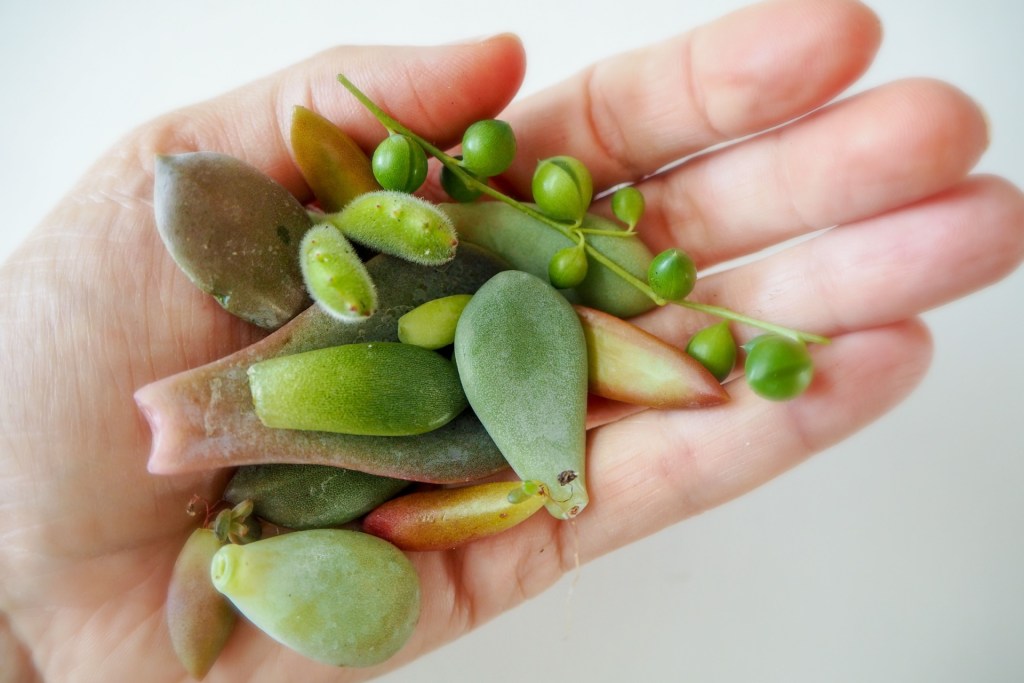
How to propagate your trailing succulent plant
You can actually root trailing succulent plants in water, but the easiest way to go about propagating them is to simply stick them onto soil.
Step 1: Fill a small planter (about 2 to 4 inches big) with cactus soil.
Step 2: Take at least a 2-inch cutting from an existing string succulent plant. Make sure the leaves are still plump and healthy.
Step 3: Coil the string on top of the soil and push the stems into the growing medium.
Step 4: Alternatively, you can pluck off a few bottom leaves and anchor the nodes into the soil. You can add more stems to fill out your planter.
Step 5: Mist your soil gently and wait for roots to emerge in about two weeks or so.
Troubleshooting problems with your trailing succulent plant
Hanging basket succulents are relatively low maintenance, but this doesn’t mean they’re immune from all issues. Here are a few problems that may appear and solutions that could help.
- Wrinkled leaves: Wrinkled, deflated leaves are a telltale sign of an underwatered plant. Give your plant a good soaking. You might also want to move your plant into a shadier area because too much heat and light may dry out the leaves.
- Thin, leggy stems: If your plant looks leggy and doesn’t have a lot of leaves, this may be due to lack of light. Move your plant to a brighter area or supplement your natural light with artificial grow lights.
- Dropping leaves: This is usually a symptom of overwatering, especially if your leaves feel extra turgid, or on the other hand, extra mushy. Cut back on watering. Inspect the roots for any root rot. You may need to repot your plant, or in the worst-case scenario, take salvageable cuttings and propagate them.
- White, waxy residue: Discoloration on your string succulent may be due to pests, such as aphids (greenish brown) and mealybugs (white), as pests enjoy sucking on succulent juices. In most cases, you’ll want to treat these issues with neem oil or insecticidal soap.
As long as you’re mindful about lighting, repotting, and watering, you’ll be the proud owner of a prolific trailing succulent plant. Inspect your plant every so often for any desiccated foliage, dropping leaves, or discoloration to tackle issues as they come. Careful attention will help you address problems immediately so you can enjoy plump tendrils and even propagate them to share with fellow succulent enthusiasts.
